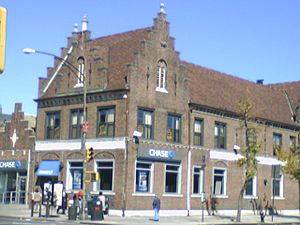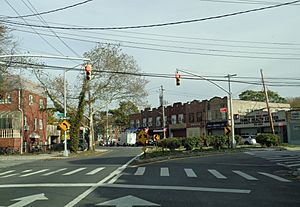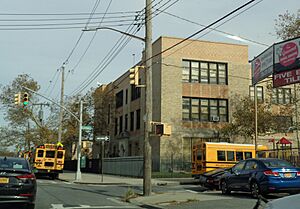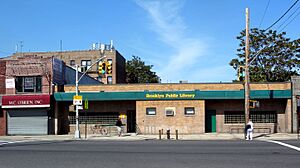Flatlands, Brooklyn facts for kids
Quick facts for kids
Flatlands
|
|
|---|---|
|
Neighborhood of Brooklyn
|
|
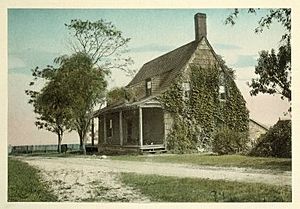
Jans Martense Schenck house, Flatlands, built 1675, formerly at Avenue U and East 63rd Street
|
|
| Country | |
| State | |
| City | |
| Borough | |
| Community District | Brooklyn 18 |
| Area | |
| • Total | 2.2800 sq mi (5.9053 km2) |
| Population
(2010)
|
|
| • Total | 64,762 |
| • Density | 28,403.8/sq mi (10,966.76/km2) |
| Ethnicity | |
| • Black | 66.3% |
| • White | 18.2 |
| • Hispanic | 8.9 |
| • Asian | 4.0 |
| • Other | 2.6 |
| Time zone | UTC−5 (Eastern) |
| • Summer (DST) | UTC−4 (EDT) |
| ZIP Code |
11234
|
| Area codes | 718, 347, 929, and 917 |
Flatlands is a neighborhood in the southeast part of the borough of Brooklyn in New York City. Its borders are roughly the Bay Ridge Branch to the north, Avenue U to the south, Ralph Avenue to the east, and Flatbush Avenue to the southwest.
Flatlands was once an independent town. It became part of the City of Brooklyn in 1896.
Today, Flatlands is part of Brooklyn Community District 18. Its main ZIP Code is 11234. The New York City Police Department's 63rd Precinct helps keep the area safe.
Contents
Exploring the History of Flatlands
Flatlands was first known as Nieuw Amersfoort. It was named after a city in the Netherlands. This area started as a farming community in 1636. Wolfert Gerritse Van Couwenhoven and Andries Hudde bought 15,000 acres of land. This land was around what is now Kings Highway and Flatbush Avenue.
Early Inhabitants and Land Use
The land was supposedly bought from the Native Lenape people. They had lived near the rich fishing waters of Jamaica Bay for a thousand years. However, the Lenape leaders did not believe in land ownership. They likely thought they were making a deal about using the land.
Wealthy Dutch landowners saw things differently. Within two generations, the Canarsee tribe of the Lenape almost disappeared. This was due to conflicts with Europeans and other tribes. Diseases also greatly reduced their numbers.
Flatlands was given the right to rule itself in 1661. This was granted by Peter Stuyvesant. It was one of the five Dutch Towns on Long Island.
The town grew slowly at first. This was because it lacked good roads. There was no easy way to connect with other parts of Brooklyn. Flatlands joined the city of Brooklyn in 1896. At that time, it included many small islands in Jamaica Bay. These islands included Mill Island, Bergen Island, and Barren Island.
Farming and Historic Buildings
Farmers in Flatlands grew many crops. These included beans, corn, and tobacco. They also harvested oysters and clams from Jamaica Bay.
The wealthy families in Nieuw Amersfoort used enslaved people to work their farms. In 1827, New York state declared all enslaved people free. After this, many Black laborers continued farming. They often worked on the same farms where they had been enslaved.
Historic Homes and Structures
Flatlands has several historic homes. The Stoothoff-Baxter-Kouwenhaven House and Joost Van Nuyse House date back to the 1700s.
Another important building is the Hendrick I. Lott House. It was built around 1720. This house was a stop on the Underground Railroad. This secret network helped enslaved people find freedom. The Flatlands Dutch Reformed Church was founded by Pieter Clausen Wycoff. It is also a historic site.
Population and Community Life
Based on the 2010 United States Census, Flatlands had 64,762 people. This was a small decrease from 2000. The neighborhood covers about 1,249 acres.
Most people in Flatlands are middle-aged adults and young people. About 25% are under 18 years old. Around 29% are between 25 and 44. Another 24% are between 45 and 64.
The average household income in this area was $76,647 in 2016. About 15% of residents live in poverty. This is lower than the average for Brooklyn and New York City.
Shopping and Local Services
The main shopping areas in Flatlands are Utica Avenue, Flatbush Avenue, Avenue N, and Ralph Avenue. Many residents also shop at Kings Plaza. This large indoor mall is located nearby. It sits at the edge of Flatlands, Marine Park, and Mill Basin.
Fire Safety and Post Offices
The New York City Fire Department (FDNY) has a fire station in Flatlands. Engine Co. 309/Ladder Co. 159 is located at 1851 East 48th Street.
Flatlands uses ZIP Code 11234. The United States Post Office has two stations here. The Canarsie Station is at 10201 Flatlands Avenue. The Ryder Station is at 2222 Flatbush Avenue.
Education in Flatlands
Many adults in Community District 22 have a college education. About 40% of residents aged 25 and older have a college degree or higher. This is similar to the rest of New York City.
The rate of elementary school students missing school is lower here. This is good news for education in Flatlands.
Local Schools
Flatlands has several public elementary schools. They serve students from pre-kindergarten to 5th grade:
- PS 119 Amersfort
- PS 203 Floyd Bennett
- PS 251 Paerdegat
- PS 326 (grades PK-2)
Other schools are located nearby:
- PS 207 Elizabeth G Leary (grades PK-8), in Marine Park
- PS 222 Katherine R Snyder (grades PK-5), in Marine Park
- PS 236 Mill Basin (grades PK-5), in Mill Basin
- PS 312 Bergen Beach (grades PK-5), in Bergen Beach
- JHS 78 Roy H Mann (grades 6–8), in Bergen Beach
- Brooklyn Theatre Arts High School (grades 9–12), in Canarsie
Public Libraries
The Brooklyn Public Library (BPL) has two branches in Flatlands. The Flatlands branch is at 2065 Flatbush Avenue. It opened in 1949 in a former bank. It moved to its current larger space in 1955.
The Paerdegat branch is at 850 East 59th Street. It opened in 1950. It moved to its current building in 1959.
Getting Around: Transportation
Flatlands does not have New York City Subway service directly within it. However, many residents can walk to the IRT Nostrand Avenue Line (2 and 5 train). This subway line ends at Flatbush and Nostrand Avenues.
Other residents use buses to reach other subway lines. These include the BMT Brighton Line (B and Q train) or the BMT Canarsie Line (L train). Local and express buses are also popular ways to travel. As of August 2019, these buses serve Flatlands: B2, B6, B7, B9, B41, B44, B44 SBS, B46, B46 SBS, B47, B82, B82 SBS, B100, B103, BM1, BM2, Q35.
Notable People from Flatlands
- Neil Bogart (1943–1982), who started Casablanca Records, grew up in the Glenwood Houses project in Flatlands.
- Chris Mullin (born 1963), a former NBA basketball player, was born and raised here.
- Steven Van Voorhees (1600–1684), an early leader and the first Voorhees in America.
- Wolfert Gerritse Van Couwenhoven (1579–1662), a Dutch colonist and one of the first landowners.
See also
 In Spanish: Flatlands (Brooklyn) para niños
In Spanish: Flatlands (Brooklyn) para niños


